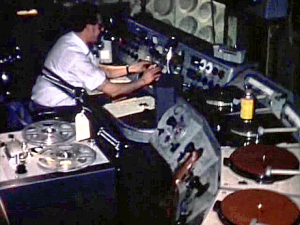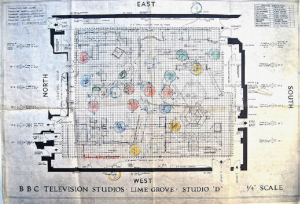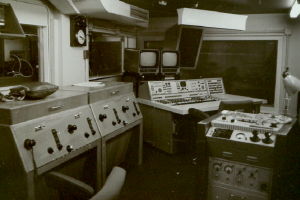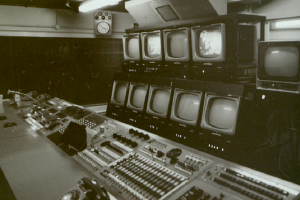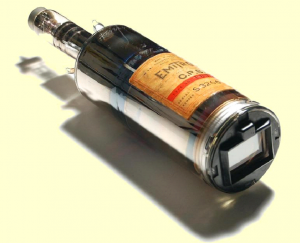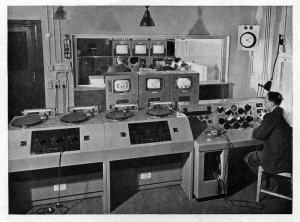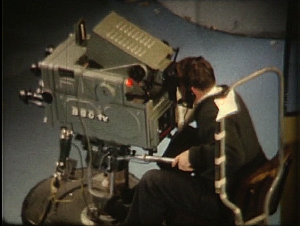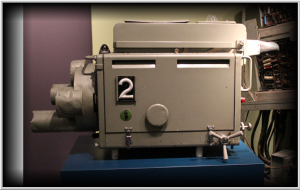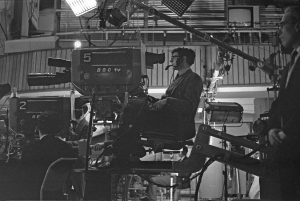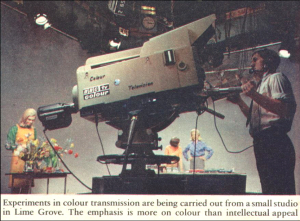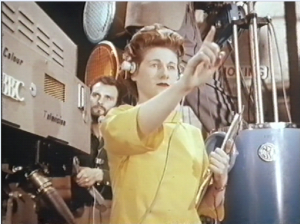This conversation started with a query to Pat Heigham from a colleague Richard Bignell.
Richard Bignell
I wonder if you could help with a quick query?
I’ve been looking at the clip of cine footage you took that we used on the “Doctor Who” DVD a while ago, showing yourself and Jack Brummitt up in the gallery of Lime Grove D and I’ve been trying to place where the sound gallery would have been at that time.
(Click on the picture below to see larger version:
use your Browser’s BACK button to return to this page)
Below is a link to a Studio D floorplan from the very first “Doctor Who” episode, which shows the Control Room on the North wall.
Click on this picture to go the original, larger one on the tvstudiohistory website:
Is this where you would have shot your footage? There’s the word “Window” on the plan marked under the word “Room”, so I wondered if this was where we are looking down onto the studio below. Or have I got the geography wrong on this? If this is correct, then presumably you would have been situated directly next to the vision mixing area where the director sat. Was the whole control room open plan or was there a dividing wall between the sound gallery and the rest of it?
Pat Heigham
The control galleries were on the floor above the studio level, and Studio D was upstairs anyway.
The window in shot, through which one can make out the interior Tardis set, was at right angles to the sound desk and the sound and production galleries were separated by a wall with a window, which was more or less obstructed by monitors on both side. The sound desk faced this wall/window.
There was a door to the fire escape on the left of the camera shot, which was a quick way in and out to the LG canteen, so if we were a bit tardy after tea break, we could slip back in, hopefully unnoticed, until a cue required us to pay attention!
To get down to the studio floor required passing through the production gallery.
I cannot remember where vision/lighting control was, maybe on the studio floor level.
Barry Bonner
Here’s some ancient pictures I took of studio D Sound Control Room. EMI sound desk probably late 1960s (after refurbishment to use IO cameras (APB)). To get to the studio floor the door is to the right of the picture.
(Click on the pictures below to see a larger version:
use your Browser’s BACK button to return to this page)
Sound Control Room
Production Control Room
You suffered a lot of journalistic traffic during “Newsnight” as they had to come through the SCR to get to the Production Gallery carrying their vital bits of script….very annoying, especially when one of them tripped on a mains lead and depowered my studio mics limiter trolley which I only discovered when we came out of TK to a studio discussion! I had a word in his ear afterwards….just one word!
The lighting gallery was on the studio floor level.
John Howell (Hibou)
I think it should be pointed out that the Production and Sound galleries had swapped places by the time Barry’s photos were taken so the sound control room gained quick access to the studio floor but lost its short cut to the canteen. I seem to remember sounding off about the load of c**p we were rehearsing with my feet firmly planted on a tape machine when Controller BBC 2 Aubrey Singer appeared behind me, he must have heard but I didn’t get a ‘word in the ear’
Peter Neill
This photo of the refurbished sound gallery reminds me of an experience I had in that Gallery.
The programme was (I think) “24 Hours”. Certainly it was a late-night live predecessor of “Newsnight”.
The opening sequence was:
| Opening (from TK or VT) | |
| Presenter headline. | |
| Tape Sting | |
| Headline 2 | |
| Tape Sting | |
| Headline 3 | |
| Tape Sting | |
| Repeat until last headline | |
| Ending off tape. |
All the stings were on one reel with leader between them, the ending was on tape machine 2.
So, the opening and first head were fine and I played the first sting, then pressed the stop button.
For those who don’t know the Leevers-Rich buttons, they were constructed in two parts – an outer shell over the inner section which contained the bulb.
When I took my finger off the stop button, the outer section was stuck to my sweaty finger tip, but flew off and landed in the gap between the two Record decks.
Presenter read HL 2
I now pressed start for the second sting – but had no means of stopping the machine. Turning the power off and on was not an option, mainly because of the large splats that would be produced on output – so I simply leant hard on the feed spool and let go for the next cue. When the last one had played I closed the fader and played the ending from the second machine (just out of shot on the right).
By the time we got into the first item the tape had reached the end and was flapping about madly as I started to move the RP2s apart to get at the missing switch top.
It was at this point that the SS (up to now oblivious to what had been going on behind him) turned round and asked, “Is everything all right?”
Alec Bray
The sound and production galleries in 1963 in both studios D and E looked very antiquated compared to the galleries in the TVC. Both sound mixing desk and the vision mixing desk had very large rotary faders, about 6 inches long, which could be retracted from their seating to be cleaned – there was a circle of contacts at the far end of the fader, and these often, it seemed, needed cleaning (or did we just like pulling out the faders?).
One day (or night, I should say), some political programme in E (I think, but may have been D) started with a 15 minute caption sequence to a pre-recorded tape (as a V/O). Now, the scene crew did not usually wear cans in those days, but rather worked off the cue lights on the camera – if the cue light went off, the caption was changed on the caption stand until the camera had been “on air” for the next one (and so on). Occasionally the FM or AFM may have given some cues to the scene crew. Now, this caption sequence was quite tricky, in that some captions were on air for a short time, some for longer, and they did not necessarily go in camera number order. And the camera were CPS Emitrons, not the most manoeuvrable. The whole crew thought it was a disaster in the making. Now, as only a few people were needed on the program (mainly captions (!)), a number of us were “let go” early – and actually it was some of the senior crew members who were in the studio. I got back home – and decided to watch the programme – did I say it was live? Of course it was! – as I had seen it rehearsed.
Caption sequence started – and went wrong from the second caption in. There was no way it could be retrieved, as the scene crew were discarding the captions as soon as the red light went off on the camera – it was an impossible task to get back to the right caption. And of course, a pre-recorded tape, so no juggling of the commentary … A total disaster.
John Howell
The Vision/Lighting Control Rooms were at studio floor level accessed by the door at grid ref 04-22.
If you look under the words "Control Room", it says Windows 4ft high at 11′ 6": those are the first floor windows in the shot. I should think the sound desk would be above the ‘H’ in NORTH.
But here’s a question for you, I remember several of the wall boxes had dials on them labelled something like "SelSync" and I see on the plan near to grid ref 04-05 a unit called "Film Unit Supply Panel" what was all this about?
Bernie Newnham
I’m pretty certain that SelSync was a way of syncing the sound and vision on a TK machine. Perhaps at some point there was a reason to have a telecine on the floor of D.
Albert Barber
SelSync used a three phase supply and you locked two motors’ phases together and started the whole thing by switching the third on to the synched motors to the third phase. You could get them to runaway if you didn’t check the locked two phases before you switched in the third.
Pat Heigham
From my later knowledge gained in the Film Industry, Sel-Sync would have been a 3-phase power supply from a central power room, for film cameras. This may have been a hangover from when LG were film studios and maybe left in place in case the BBC Film Unit had need.
For instance, a film camera shooting scenes against back-projection needs to have the camera shutter open at the same time, frame synced to the projector, thus all running off the same supply. (Pinewood had a special studio for this, that I worked in on a number of occasions.)
When the back projection film needed to be wound back to start, the camera supply had to be un-locked, otherwise the shot film would be backwards run and exposed scenes over-run again!.
I recall two programmes I worked on – one in Riverside and one in TVC – "The Cherry Orchard" and "The Year of the Sex Olympics" where the set walls were BP screens, with blimped 35mm film projectors, all running in sync from the communal supply. I can’t remember how the problem of shutter flicker was overcome, looked at by TV cameras, but I suspect that the shutters were only open once per frame, and the projectors ‘gen-locked’ to the cameras’ 50Hz drive.
Geoff Fletcher
I think that the Vision/Lighting Control Room was at studio floor level. When I started at the BBC in October 1963 at least one of the Lime Grove studios was still equipped with CPS Emitron cameras and I’m pretty sure that had racks at studio floor level – but I can’t remember which studio. I do recall that replugging the Emitron cameras required the use of a C-Spanner and often resulted in barked knuckles when the spanner slipped and your knuckles scraped against burred screw heads surrounding the cable outlet.
Hugh Sheppard
I’m sure racks were at floor level in the studio from which “Pugwash” and “Blue Peter” both originated, recalled as ‘E’.
Pat Heigham
As I recall, all the LG studios, D,E & G had CPS Emitrons at that time.
The instability of the target voltages was used to great effect on “Dr. Who”, when the Daleks used their ‘blasters’ to exterminate! A white-out with intermittent neg-pos imaging. And the wonderful background to the original opening titles was a video howlround, with the camera looking at its own output on a monitor – simple but brilliant!
(My first camera ‘operation’ was the CPS on the Grandstand results teleprinter – I had to ensure correct framing and focussing. Get it wrong, and one could expect an arse kicking from Jim Atkinson’s plimsolls! – not to mention being yelled at by ‘Ginge’.)
Rex Palmer
LG G had CPS Emitrons, which as has been mentioned before had an inherent fault that meant that if a bright light shone into the camera the output appeared to go negative and then ‘peeled off’ back to normal. It was indeed this effect that was used when the Daleks ‘zapped’ someone. When these cameras were eventually replaced, the “Doctor Who” team had to devise another effect for the Dalek’s weapon.
(Click on the picture below to see larger version:
use your Browser’s BACK button to return to this page)
Geoff Fletcher
I well remember the dreaded "peel". Other interesting quirks on the Emitrons were the wrist-twisting pinch grip lens change in the back plate of the camera; the reversal of the normal handing of the panning and focus – i.e panning handle on the right, focus on the left; and the lens turret being moved when focussing rather than the tube, as was the case on the IO cameras.
Some time later we used visual howl with IOs a lot on the pop numbers on Tony Palmer’s "Twice a Fortnight" too – by careful framing and gentle movement you could partially control it to give interesting multi image trailing effects.
Dave Mundy
I worked on the very first few “Dr. Who”s and on the experimental session in D (Friday, September 13th., 1963) to make the vision howl-round for the opening titles and the cameras were definitely CPS Emitrons.
Alec Bray
When I joined the Beeb in January 1963, studios D, E and G at Lime Grove had CPS Emitrons, Studio H had the huge Marconi colour cameras, TVT and R1 and R2 had Marconi Mk IIIs (those with the lens change at the middle bottom rear, well placed to catch sensitive parts of the anatomy). At this time, the lighting at studios D, E and G at Lime Grove was done using rope hoists and huge dimmers, manually operated by Sparks, dotted around the studio walls.
At this time, G did “Tonight” and “Grandstand” on the Saturday. One Saturday, during the ..er.. rehearsal time, one CPS Emitron slid of its ped (no one explained why or owned up). We picked it up, put it back on its ped, and it carried on, right as rain.
The CPS Emitrons focussed by moving BOTH the tube and lens turret (tube back and lens forward, for example): as the lenses had a large metal covering it was not possible (in the usual run of things) to have a zoom.
Not only did the CPS Emitrons “peel” but there was another characteristic. As the signal was based on some sort of average charge across the pickup area, if you pointed the Emitron so that a monitor was at, say , the bottom right corner of the picture, the camera would respond as if the picture on the monitor was the picture given by the lens (oh! if only I had the Wood Norton lecture notes on CPS Emitrons), so you got a sort of double exposure – a ghostly full screen monitor picture and the picture from the lens.
CPS Emitrons were used on floor 3 TVC (in 1963) in standards conversion, particularly for 525 lines 30 fps to 405 line 25 fps standards conversion .
On refurbishment, TVT and R1 and R2 got Pye Mk Vs – with a motorised lens change that was sooooooo slllllooooooowwww. On one “Marriage Lines” I had three successive shots – loose MCU, loose CU and CU on Richard Briars on a fast –paced part of the script; the shots had to be done on the lenses (as I was quite close in on the set) and only just made it for each cut.(and that also meant focussing as the lens changed). However, on the Pyes you could really get in close and stay in focus: on “Curtain of Fear” I ended up with just four lips across the screen (kissing scene) but that’s another story!. http://tech-ops.co.uk/next/the-art-of-direction/
John Howell (Hibou)
When I started I was attached to Crew 9. My diary indicates we did “Tonight” in studio G frequently from January 1963 until March 18 when we departed for Wood Norton. Can’t find the late 1962 entries but I don’t recollect G being closed at that time. That was the harsh winter when the fish tank froze because someone left the studio door open just behind it.
(Click on the picture below to see larger version:
use your Browser’s BACK button to return to this page)
Studio G SCR. I don’t know who the man at the Sound Desk is. The layout remained the same when the EMI desk arrived except the PCR seen through the window was rotated through 180 degrees such that the monitor stack backed onto the window.
Derek Martin
After my induction course at the beginning of November 1962, my first 3 days, Wednesday to Friday, were Tonight in G with crew 11.
Pat Heigham
I never worked in ‘H’ but believe that various colour or color cams were being assessed before adoption (P & ID? NTSC or PAL?)
I was Grams on “Curtain of Fear”, and I think it was Dudley Simpson who composed the opening theme. I did have a 1/4" of the music but wiped it – much to the dismay of Charles Norton who is doing his best to look after BBC Archive recordings.
| CURTAIN OF FEAR | ||
| A thriller in six parts by | VICTOR CANNING | |
| Music composed by | DUDLEY SIMPSON | |
| and played by | THE MICK BARKER QUARTET | |
| Film cameraman | David Prosser | |
| Film editor | Paddy Wilson | |
| Designer | Susan Spence | |
| Produced and directed by | GERALD BLAKE | |
| Cast: | ||
| Stewart Caxton: | George Baker | |
| Clare Linton: | Colette Wilde | |
| Peter Linton: | John Breslin | |
| Rassilov: | Reginald Jessup | |
| Man at airport: | Raymond Llewellyn | |
| Colonel Powell: | John Harvey | |
| Charles Shand: | William Lucas | |
| John Myers: | William Sherwood | |
| Helen Tovey: | Jan Holden | |
| Hans Liebert: | William Franklyn | |
| Tannikov: | George Pravda | |
| Georgi: | Makki Marseilles | |
| Renko: | Norman Jones | |
| Barman: | Paul Chapman | |
| Doorkeeper: | George Betton | |
| Regan: | Gerald Sim | |
If it was Marconi Mk 111 in the TVT, my little film shows the side panel of Eddy Stuart’s (Cam 1 on the Mole) hanging a bit loose as the tech guys were always coming out to tweak!
(Click on the picture below to see larger version:
use your Browser’s BACK button to return to this page)
The CPS Emitrons had an awful lens hood covering all lenses that resembled a bodge of coffee tins -remember?
(Click on the picture below to see larger version:
use your Browser’s BACK button to return to this page)
Peter Cook
From November 1963 to May 1964, minus Jan to Mar at ETD, I worked on studio crews 3 and 12, occasionally at LG (I was using a phone in an LG gallery a during meal break when news of Kennedy’s assassination came on an off air screen). I also distinctly remember that there were two types of camera in different studios, one camera type was CPS Emitron which peeled, the other type was IO, which didn’t peel. I know it was not a Marconi Mk 3, as I first encountered one of those at Lords when working as relief to a Birmingham OB unit, probably in 1965. (London OB’s had Pye cameras) Being unfamiliar there was a significant pause when during line up the racks engineer wanted orbit switched off; I was used to that being remote, but on the Mk 3 it was switched in the camera.
My memory also suggests that TV Theatre had Pye 5s with motorised turret, and that the green EMI 203 cameras (with 5 position turret) were in some studios at TC where others had Marconi. I can’t recall what cameras were in Riverside.
Dudley Darby
Riverside had Pye 5s along with TV Theatre at the end of 1963/beginning 1964. LG had CPS Emitrons, E was having its cameras replaced with EMI 4½” IOs in October 1963, and I believe G already had EMI 203s. Marconi Mk 4s were only at TVCentre in TC2, TC3, and later TC7 for a while. OBs had Pye 6s without the motorized turret. They made a short appearance in TVT after a refurbishment shortly before it was colourised.
Geoff Fletcher
Here’s a Pye camera at the TV Theatre – a young Mr Healey hiding behind the beast!
(Click on the picture below to see larger version:
use your Browser’s BACK button to return to this page)
Graeme Wall
The Pye Mk Vs ended up at Ally Pally for the Open University in the mid 1970s. I spent a very pleasant summer up there one year on attachment.
Dave Mundy, Bill Jenkin, Clifford White
When I looked into Studio H the cameras were enormous Marconi BD 848 cameras, virtually identical to the RCA TK31s,with 3 off 3" IOs. The evening test TX was useful because you could take your holiday slides in to show the world!
The Colour Studio H in 1965:
(Click on the picture below to see larger version:
use your Browser’s BACK button to return to this page)
Pat Heigham, Bernie Newnham
Bernie has a copy of Richard Cawston’s film of "This is the BBC" which includes an experimental colour sequence in studio A, Ally Pally:
(Click on the picture below to see larger version:
use your Browser’s BACK button to return to this page)
Dick Blencowe
I remember exploring what was left of Lime Grove and finding a large hole in the wall of the old Cash Office near the Scenery run way where a time capsule, placed when the building was built (was it in the 1920’s?) had been removed. Anyone know what was in it or whether it still exists? I seem to remember an article in “Aerial” about it.
Bill Jenkin, Chris Booth
There’s an old “Blue Peter” item about this. It is on the VTOldboys website You can find it at:-
http://www.vtoldboys.com/galleries/lgmenu.htm
It’s the “Blue Peter” item.


